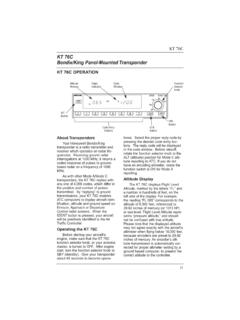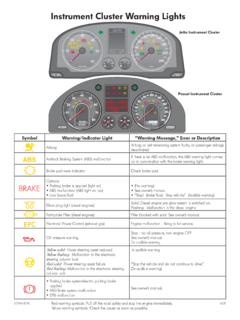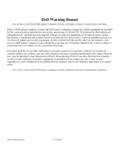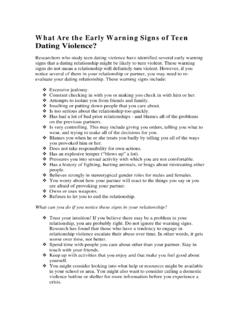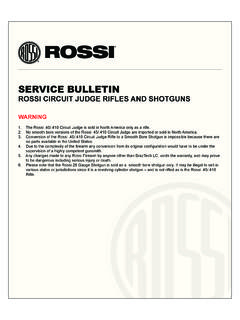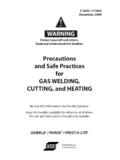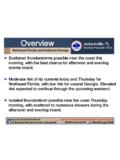Transcription of Textron Pilot Safety and Warning Supplements
1 Pilot Safety and Warning Supplements A Textron Company The information contained in this document is not intended to supersede the Owner's Manual or Pilot 's Operating Handbook applicable to a specific airplane. If there is a conflict between this Pilot Safety and Warning supplement and either the Owner's Manual or Pilot 's Operating Handbook to a specific airplane, the Owner's Manual or Pilot 's Operating Handbook shall take precedence. This publication replaces the original issue (05099-13) in its entirety. o Member of GAMA 05139-13 COPYRIGHT 1998 Cessna -Aircraft Company Wichita, Kansas USA Original Issue - 2 October 1985 Reissue -1 June 1998 Pilot Safety AND Warning Supplements CONTENTS INTRODUCTION FLIGHT CONSIDERATIONS CONTENTS supplement PhYSiological.
2 1 Checklists .. 2 Aircraft Loading .. 3 Single Engine Flight Information (Multi-engine Airplanes) .. 4 Pilot Proficiency .. 5 Fuel Management .. 6 Airframe Icing .. 7 Weather .. 8 SYSTEM OPERATIONAL CONSIDERATIONS Restraint Systems .. 9 Fuel System Contamination .. 10 Fuel Pump Operation .. 11 Auxiliary Fuel Tanks .. 12 Instrument Power .. 13 Alternate Air System .. 14 Carbon Monoxide .. 15 Turbocharger .. 16 In-Flight Fires .. 17 In-Flight Opening of Doors .. 18 MAINTENANCE CONSIDERATIONS Maintenance .. 19 Seat and Restraint Systems .. 20 Exhaust and Fuel Systems .. 21 Retractable Landing Gear .. 22 Pressurized Airplanes .. 23 Potential Hazards .. 24 Reissue - 1 June 1998 i/(ii blank) e.
3 Pilot Safety AND Warning Supplements INTRODUCTION INTRODUCTION pilots should know the information contained in the airplane's operating handbook, placards and checklists, and be familiar with service/maintenance publications, including service letters and bulletins, to ensure maximum safe utilization of the airplane. When the airplane was manufactured, it was equipped with a Pilot 's Operating Handbook, Flight M~nual, and/or Owner's Manual. If a handbook or manual is missing, a replacement should be obtained by contacting a Cessna Authorized Service Station. In an effort to re-emphasize subjects that are generally known to most pilots , Safety and operational information has been provided in the following Pilot Safety and Warning Supplements .
4 As outlined in the table of contents, the Supplements are arranged numerically to make it easier to locate a particular supplement . supplement coverage is classified in three (3) categories: Flight Considerations, System Operational Considerations, and Maintenance Considerations. Most of the information relates to all Cessna airplanes, although a few Supplements are directed at operation of specific configurations such as multi-engine airplanes, pressurized airplanes, or airplanes certified for flight into known icing conditions. Day-to-day Safety practices play a key role in achieving maximum utilization of any piece of equipment. Warning IT IS THE RESPONSIBILITY OF THE Pilot TO ENSURE THAT ALL ASPECTS OF PREFLIGHT PREPARATION ARE CONSIDERED BEFORE A FLIGHT IS INITIATED.
5 ITEMS WHICH MUST BE CONSIDERED INCLUDE, BUT ARE NOT NECESSARILY LIMITED TO, THE FOLLOWING: Pilot PHYSICAL CONDITION AND PROFICIENCY AIRPLANE AIRWORTHINESS AIRPLANE EQUIPMENT APPROPRIATE FOR THE FLIGHT AIRPLANE LOADING AND WEIGHT AND BALANCE ROUTE OF THE FLIGHT WEATHER DURING THE FLIGHT FUEL QUANTITY REQUIRED FOR. THE FLIGHT, INCLUDING ADEQUATE RESERVES' AIR TRAFFIC CONTROL AND EN ROUTE NAVIGATION FACILITIES FACILITIES AT AIRPORTS OF INTENDED USE (Continued Next Page) Reissue - 1 June 1998 1 ;.. i" r "f'. ~ .. , ~ It I~L t ~ .. , ~ If \t 1. INTRODUCTION Pilot Safety AND Warning Supplements Warning (Continued) ADEQUACY OF AIRPORT (RUNWAY LENGTH, SLOPE, CONDITION, ETC.)
6 LOCAL NOTICES, AND PUBLISHED NOTAMS FAILURE TO CONSIDER THESE ITEMS COULD RESULT IN AN ACCIDENT CAUSING EXTENSIVE PROPERTY DAMAGE AND SERIOUS OR EVEN FATAL INJURIES TO THE Pilot , PASSENGERS, AND OTHER PEOPLE ON THE GROUND. The following Pilot Safety and Warning Supplements discuss in detail many of the subjects which must be considered by a Pilot before embarking on any flight. Knowledge of this information is considered essential for safe, efficient operation of an airplane. Proper flight Safety begins long before the takeoff. A Pilot 's attitude toward Safety and safe operation determines the thoroughness of the preflight preparation, including the assessment of the weather and airplane conditions and limitations.
7 The Pilot 'S physical and mental condition and proficiency are also major contributing factors. The use. of current navigation charts, the Aeronautical Information Manual, NOTAMs, airport data, weather information, Advisory Circulars and training information, etc., is important. Individuals often develop their own personal methods for performing certain flight operations; however, it is required that these do not conflict with the limitations or recommended operating procedures for a specific airplane. The Pilot should know the Emergency Procedures for the airplane, since there may not be time to review the checklist in an emergency situation. It is essential that the Pilot review the entire operating handbook to retain familiarity.
8 He or she should maintain a working knowledge of the limitations of his or her airplane. When the Pilot deliberately or inadvertently operates the airplane outside the limitations, he or she is violating Federal Aviation Regulations and may be subject to disciplinary actions. Cessna does not support modifications to Cessna airplanes, whether by Supplemental Type Certificate or otherwise, unless these certificates are approved by Cessna. Such modifications, although approved by the FAA, may void any and all Cessna warranties on the airplane since Cessna may not know the full effects on the overall airplane. Cessna does not and has not tested and approved all such modifications by other companies.
9 Maintenance and operating procedures and performance data provided by Cessna may no longer be accurate for the modified airplane . Airplanes require maintenance on a regular basis. As a result, it is essential that the airplane be regularly inspected and repaired when parts are worn or damaged in order to maintain flight Safety . Information for the proper maintenance of the airplane is found in the airplane Service/Maintenance Manual, Illustrated Parts Catalog, and in, company-issued Service Information 2 " Reissue - 1 June 1998 Pilot Safety AND Warning Supplements INTRODUCTION Letters or Service Bulletins, etc. pilots should assure themselves that all recommendations for product changes or modifications called for by Service Bulletins, etc.
10 , are accomplished and that the airplane receives repetitive and required inspections. Much of the subject matter discussed in the following Supplements has been derived from various publications of the Government. Since these documents contain considerably more information and df;ltail than is contained here, it is highly recommended that the Pilot also read them in order to gain an even greater understanding of the subjects related to flight Safety . These publications include the following: AERONAUTICAL INFORMATION MANUAL (AIM). This Federal Aviation Administration (FAA) manual is designed to provide airmen with basic flight information and Air Traffic Control (ATC) procedures for use in the National Airspace System (NAS).
